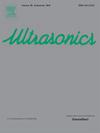用粘接柔性换能器在薄板上产生和感应兰姆波的解析解
IF 3.8
2区 物理与天体物理
Q1 ACOUSTICS
引用次数: 0
摘要
尽管在驱动、传感和能量收集应用方面对柔性电装置进行了大量研究,但它们在薄壁结构中产生和传感导波的潜力在很大程度上尚未得到检验。本文提出了一个理论模型,用于驱动和传感薄各向同性板上的兰姆波,利用物理建模粘接柔性换能器。该模型结合了剪切和剥离应力在键合层,以促进传感器和主板之间的应力传递。通过将致动器和板建模为基尔霍夫板,确定了致动器对板表面的牵引力。利用弹性理论在波数域和频域暂时得到板的兰姆波响应,然后利用残差定理和傅里叶反变换将其转换为空间和时间域。利用基尔霍夫板理论对传感器和板的假设来评估从板到柔性电传感器的应变传递以及由此产生的电势。为了验证,将基材上表面的纵向应变与ABAQUS基于连续体的有限元结果进行了比较。数值研究了电场梯度、换能器厚度和胶粘剂厚度对板的时域和频域Lamb波响应和传感器输出的影响。阐述了挠性电和压电产生的兰姆波信号的特性。该模型对于实现柔性电材料在材料表征、医学诊断和结构健康监测等方面的应用具有重要意义。本文章由计算机程序翻译,如有差异,请以英文原文为准。
Analytical solution for Lamb wave generation and sensing in thin plates through adhesively bonded flexoelectric transducers
Despite numerous studies on flexoelectric devices for actuation, sensing, and energy harvesting applications, their potential for generating and sensing guided waves in thin-walled structures has been largely unexamined. This article presents a theoretical model for the actuation and sensing of Lamb waves in thin isotropic plates, utilizing physically modelled adhesively bonded flexoelectric transducers. The model incorporates shear and peel stresses in the bonding layers to facilitate stress transfer between the transducers and the host plate. The tractions induced by the actuator onto the plate surface are determined by modelling the actuator and plate as Kirchhoff plates. The Lamb wave response of the plate is obtained using elasticity theory in the wavenumber domain spatially and frequency domain temporarily, then converted to space and time domains using the residual theorem and inverse Fourier transform. The strain transfer from the plate to the flexoelectric sensor, along with the resulting electric potential, is evaluated utilizing Kirchhoff plate theory assumptions for the sensor and the plate. For validation, the longitudinal strain at the substrate’s top surface is compared with ABAQUS’ continuum-based finite element results. Numerical studies are presented to demonstrate the influence of the electric field gradient and the thickness of the transducer and adhesive on the time- and frequency-domain Lamb wave response of the plate and the sensor output. The characteristics of the Lamb wave signals produced by flexoelectricity and piezoelectricity are illustrated. The developed model is crucial for realizing applications of flexoelectric materials in material characterization, medical diagnosis, and structural health monitoring.
求助全文
通过发布文献求助,成功后即可免费获取论文全文。
去求助
来源期刊

Ultrasonics
医学-核医学
CiteScore
7.60
自引率
19.00%
发文量
186
审稿时长
3.9 months
期刊介绍:
Ultrasonics is the only internationally established journal which covers the entire field of ultrasound research and technology and all its many applications. Ultrasonics contains a variety of sections to keep readers fully informed and up-to-date on the whole spectrum of research and development throughout the world. Ultrasonics publishes papers of exceptional quality and of relevance to both academia and industry. Manuscripts in which ultrasonics is a central issue and not simply an incidental tool or minor issue, are welcomed.
As well as top quality original research papers and review articles by world renowned experts, Ultrasonics also regularly features short communications, a calendar of forthcoming events and special issues dedicated to topical subjects.
 求助内容:
求助内容: 应助结果提醒方式:
应助结果提醒方式:


